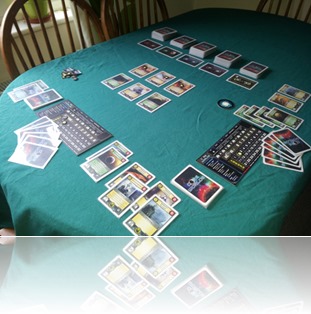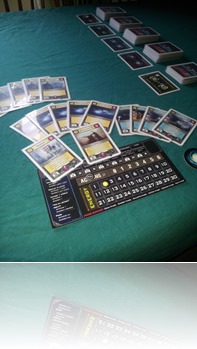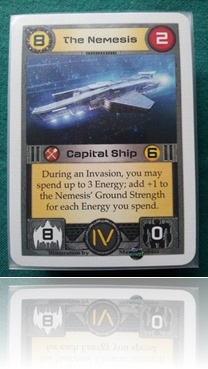![pic1063921_t[1] pic1063921_t[1]](https://www.gmsmagazine.com/wp-content/uploads/pic1063921_t1.jpg) By Michael Chamberlain
By Michael Chamberlain
Core Worlds released in 2011 and marketed as “A deck-building card game of intergalactic conquest” was a game I came to with very high hopes. I had grown weary of bland deck builders but still liked the idea of deck building in concept. Core worlds is themed around the decay of the civilization and your journey from being a barbarian star empire on the outskirts of its boards, to amassing your own power and making a bid to conquer the core worlds of this once great empire for your own.
Upon opening the box for this game I felt frankly gutted. The contents of this fairly substantial box was a few wraps of cards (210 cards in total), a board with a couple of dozen chits and some very thin card player ‘boards’. All of this within a cardboard insert so badly sized that the player boards don’t actually fit within it. Thankfully from here it does get better. Once you open the card wraps you are blasted with fantastic sci-fi art on all of the game cards and to back this up a very nicely laid out and clear rule book. The cards break down into five faction decks which are the player start decks, all consisting of the same basic cards with each deck also having its own hero card specific to that faction. There are also five sector decks that you will make your way through, starting in deck one on the outer edges of the ancient galactic realm and working inwards to sector five, home to the core worlds. Each of these decks also comes with a sector card listing how many actions you take in that round and marking your progress through the game with spaces for the round marker. Once you are used to the game the player boards turn out to be very well designed with clear space for tracking actions and energy (the two main resources of the game) and with the requirements and effects of the core worlds you can aim towards for end of game scoring.
Set up for the game is quick and easy. Each player draws a home world at random that they place in their ‘warzone’ (tableau) and take the corresponding faction deck. Each play gets a player board and markers to track energy and action and the player whose home would has the lowest number also takes the destiny marker (start player token). Then the five sector decks are shuffled separately and laid in order in front of their sector cards with the round marker placed on the left most space of sector one. With that done you are ready for play.
 A game round breaks down into six phases: Draw, Energy, Galactic, Action, Discard and End. In the draw phase each player draws up to a hand of six cards. Certain effects in the game can increase this but by and large the draw phase is that simple. The energy phase is a little more involved with you totalling all of the energy values of the planets in your war zone (to begin with this will be three for all starting worlds) there is also the chance to discard two cards to generate an additional energy or play tactics such as Energy Surge cards to boost your energy for the round. During the galactic phase the central pool of cards is filled. Cards more than one round old are removed and new cards are added from the current sector deck. Cards remaining from the previous round get energy tokens placed on them. Cards in the central zone come in four types: Units – which can be deployed to your war zone. Tactics – which are played to generate in game effects. Worlds – These can be conquered for empire points and energy, also some have useful in game effects. Finally prestige cards – which are worth empire points at the end of the game. The Action phase is the real meat of the game where players get to make most of their choices. Players take actions in turn until everyone is out of actions. The actions you can take are: Draft a card, Deploy units, Invade a world, use an action ability or pass. Unit, Tactics and Prestige cards can be drafted for their draft cost. When a card is drafted a player expends an action and the draft cost in energy from their pool placing the drafted card into your discard pile. If you drafted a card with an energy token on it you gain an energy. Deploying units is a vital action in this game on the road to conquering planets as each unit has both a ground and fleet strength value. As with world cards many units cards have useful in game abilities while they are in your warzone. To deploy a unit you need to pay it’s deploy cost and one action.
A game round breaks down into six phases: Draw, Energy, Galactic, Action, Discard and End. In the draw phase each player draws up to a hand of six cards. Certain effects in the game can increase this but by and large the draw phase is that simple. The energy phase is a little more involved with you totalling all of the energy values of the planets in your war zone (to begin with this will be three for all starting worlds) there is also the chance to discard two cards to generate an additional energy or play tactics such as Energy Surge cards to boost your energy for the round. During the galactic phase the central pool of cards is filled. Cards more than one round old are removed and new cards are added from the current sector deck. Cards remaining from the previous round get energy tokens placed on them. Cards in the central zone come in four types: Units – which can be deployed to your war zone. Tactics – which are played to generate in game effects. Worlds – These can be conquered for empire points and energy, also some have useful in game effects. Finally prestige cards – which are worth empire points at the end of the game. The Action phase is the real meat of the game where players get to make most of their choices. Players take actions in turn until everyone is out of actions. The actions you can take are: Draft a card, Deploy units, Invade a world, use an action ability or pass. Unit, Tactics and Prestige cards can be drafted for their draft cost. When a card is drafted a player expends an action and the draft cost in energy from their pool placing the drafted card into your discard pile. If you drafted a card with an energy token on it you gain an energy. Deploying units is a vital action in this game on the road to conquering planets as each unit has both a ground and fleet strength value. As with world cards many units cards have useful in game abilities while they are in your warzone. To deploy a unit you need to pay it’s deploy cost and one action.  Unlike other actions you can spend multiple actions deploying units without the turn passing to the next player. To conquer planets you need to announce your target planet for invasion and discard from your warzone sufficient to exceed its fleet and ground defence strengths. To help you do this there are a number of tactics cards that have ‘during an invasion’ effects that can bolster your attacking forces. You then get to take the world and add it to your war zone ready to generate more energy for the next round, to gain empire points and effects from. The Pass action is one you really want to avoid, if you pass it drains all of your remaining energy and actions, there is no waiting to see what the next player does and then come back in after if you pass that is it for the round. The discard phase is a little different to most deck builders. In Core Worlds you may if you wish retain one card (usually you would discard your whole hand). This is frankly huge and gives a great way to save tactics cards for the next turn or setting up for having the energy to deploy bigger units after conquering more planets. Finally, in the end phase the round marker moves on a space and players set their actions points for the next round according to the sector card. In the ninth and tenth rounds the Core World and Prestige cards will enter play (no units or tactics cards) these are big scoring cards with each of the core worlds linked to a card type and granting bonus points for each card of that type you have in your empire. In the tenth round instead of the usual count of cards being put into play in the galactic phase the remainder of the deck gets played, so every core world is available every game. At the end of the tenth round empire points are totalled with the winner being the player with the most (just don’t expect the scores to be very high).
Unlike other actions you can spend multiple actions deploying units without the turn passing to the next player. To conquer planets you need to announce your target planet for invasion and discard from your warzone sufficient to exceed its fleet and ground defence strengths. To help you do this there are a number of tactics cards that have ‘during an invasion’ effects that can bolster your attacking forces. You then get to take the world and add it to your war zone ready to generate more energy for the next round, to gain empire points and effects from. The Pass action is one you really want to avoid, if you pass it drains all of your remaining energy and actions, there is no waiting to see what the next player does and then come back in after if you pass that is it for the round. The discard phase is a little different to most deck builders. In Core Worlds you may if you wish retain one card (usually you would discard your whole hand). This is frankly huge and gives a great way to save tactics cards for the next turn or setting up for having the energy to deploy bigger units after conquering more planets. Finally, in the end phase the round marker moves on a space and players set their actions points for the next round according to the sector card. In the ninth and tenth rounds the Core World and Prestige cards will enter play (no units or tactics cards) these are big scoring cards with each of the core worlds linked to a card type and granting bonus points for each card of that type you have in your empire. In the tenth round instead of the usual count of cards being put into play in the galactic phase the remainder of the deck gets played, so every core world is available every game. At the end of the tenth round empire points are totalled with the winner being the player with the most (just don’t expect the scores to be very high).
Core worlds takes a lot of explaining as a game for something that in the end feels fairly intuitive. The game’s turn structure is dynamic enough to mean that even when it isn’t your turn you’re watching what the other players are doing in a way that very much reminds me of worker  placement style games. The choices all feel relevant to what you are trying to achieve and some of the cards are just downright cool. For example, the Nemesis Capital Ship gives eight points of fleet strength and the ability to pump energy into it to give it ground strength and is also worth empire points. The tableau aspect to this game and the ability to retain a card until the next turn really elevates this game into something different. Is the game without fault? No of course it’s not. There are moments of irritation where you get beaten to the punch on planets by other players (which is fine until it’s a core world) but there are official variants that fix this problem. The contents of the box when first opened seem woefully little when compare to the price tag for the game, but after many much enjoyed plays I can only feel its evident that its value is in its great art work and elegant, well balanced game play. It is a brain burner which is not what we have come to expect from most deck builders, so much so that this isn’t really a deck builder to my mind. This takes the deck building mechanic that is enjoyable and gives you a game with meaning and depth to play. So while it isn’t perfect to my mind it is about as close as games get. This one is going nowhere and I can’t ever see myself turning down a game.
placement style games. The choices all feel relevant to what you are trying to achieve and some of the cards are just downright cool. For example, the Nemesis Capital Ship gives eight points of fleet strength and the ability to pump energy into it to give it ground strength and is also worth empire points. The tableau aspect to this game and the ability to retain a card until the next turn really elevates this game into something different. Is the game without fault? No of course it’s not. There are moments of irritation where you get beaten to the punch on planets by other players (which is fine until it’s a core world) but there are official variants that fix this problem. The contents of the box when first opened seem woefully little when compare to the price tag for the game, but after many much enjoyed plays I can only feel its evident that its value is in its great art work and elegant, well balanced game play. It is a brain burner which is not what we have come to expect from most deck builders, so much so that this isn’t really a deck builder to my mind. This takes the deck building mechanic that is enjoyable and gives you a game with meaning and depth to play. So while it isn’t perfect to my mind it is about as close as games get. This one is going nowhere and I can’t ever see myself turning down a game.
Mav.
